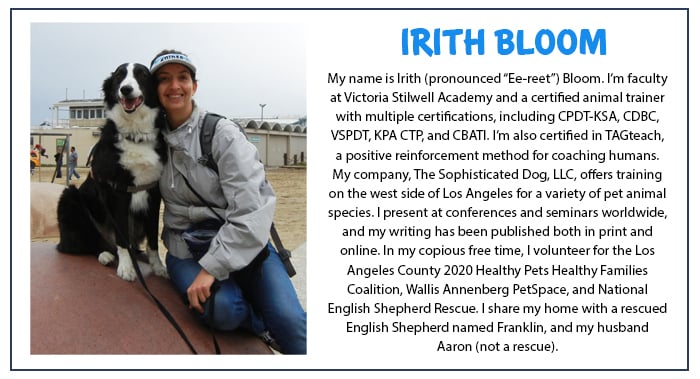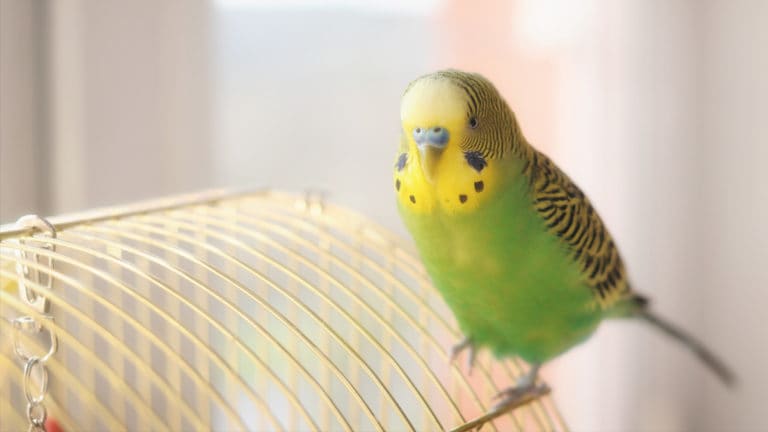Dogs. They poke their noses where they’re not wanted, beg at the dinner table and get underfoot while you’re cleaning. I can’t tell you how many times a client has asked me how to make their dog stop [insert annoying, in-the-way behavior here].
Fortunately, there is a simple dog obedience behavior you can teach your pup to do that works in all kinds of situations. In fact, I’d say it’s among the most popular dog obedience tips I offer to clients!
So, what’s this magical behavior you can teach at home for day to day situations? It’s settling on a mat on cue.
When a dog is on his mat, he’s not somewhere else—which makes this a great dog obedience behavior for times when your pup is in the wrong place. Once your canine companion knows how to settle on his mat on cue, you can send your pet to his mat anytime you feel it’s needed.
How to Train Your Dog to Go to His Mat on Cue
1. First thing’s first—grab your dog’s favorite dog training treats and a suitable mat. You and your dog might enjoy the Frisco fleece bed and mat because it provides cushion but is lightweight enough to pick up and move it wherever you want your dog to settle.
2. Put the mat down near your dog.
3. Wait quietly. As soon as he looks at or steps towards the mat, praise your dog and put a treat on the mat. Because the treat is on the mat, your dog almost certainly will step onto the mat to get the treat.
Note: If you and your dog are familiar with the clicker, you can click instead of praising, and then feed a treat on the mat. Get clicker training tips here.
3. Praise your pup when his foot touches the mat, and then feed him another treat on the mat.
Repeat this about 10 times in a row.
4. Next, call your dog off the mat, and toss a couple of treats over to the side so he moves away from the mat. (You can use a release cue if your dog knows one.) While he’s busy eating the treats, pick up the mat.
5. Then, either put the mat away, or put it down in a different spot for another round of training.
Note: Be sure to keep the mat out of your dog’s reach between training sessions!
6. After a few repetitions, your dog will probably move toward the mat as soon as you put it on the floor. When he is walking over to the mat consistently, wait to praise him until all four of his paws are on the mat, or until he sits or lies down on the mat.
7. After praising and feeding one time for being on the mat, feed your dog multiple treats in a row without praising in between as long as he stays on the mat. Feed right on the mat to encourage your pet to lie down or remain lying down. After the tenth treat, release or call your dog, toss a couple of treats to the side and pick up the mat again.
8. Once your dog is lying down on the mat right away every time, you can start feeding the treats at set intervals. For example, start with one treat every second and gradually building up how long you wait between treats.
Follow this pattern:
• Feed 10 treats in a row, with 1-second pauses between treats.
• Feed 10 treats in a row, with 2-second pauses between treats.
• Feed 10 treats in a row, with 3-second pauses between treat.
Gradually build up to 10 treats in a row with 15-second pauses between treats.
Here’s the overall sequence:
A. Place mat on floor
B. Dog lies down on mat
C. Praise and feed
D. Feed 10 more times in a row at the current time interval
E. Say release cue or call dog and toss food to the side
F. Pick up mat
9. Now that your dog is lying down on the mat and staying there, it’s time to add a cue. To do this, say something like “go to bed” as you put the mat down on the floor. You can use whatever phrase you want; just be sure to say it every time you practice this behavior, right before or right as you put the mat down.
10. Once your dog understands how to go to the mat on cue and can stay there for 2 minutes and 30 seconds while you feed 10 treats, you can start adding distance. To do this, go back to feeding every second, but take a small step away between treats.
Slowly add distance, one step at a time. You also can extend the time between treats in small increments (2 seconds, 3 seconds, etc.) as you move away from the mat and then return to feed.
Note: If at any point your dog gets confused and stands up before being released or called off the mat, go back a step or two in the training and build back up more gradually again.
The goal is for you to be able to send your dog to the mat and have him lie there quietly, even as you move around, for several minutes at a time. Most dogs will learn to settle much longer with practice.
To make it easier for your dog to settle for extended periods of time, give him something to chew on while he’s on the mat, such as a Himalayan dog chew, which will keep him busy. Once your dog knows how to go to a mat on cue and settle there, you can send him there any time you need some space.
I like to use the mat when I’m cooking, at the computer, vacuuming … there are a million different scenarios when this behavior is beneficial!

Share:











